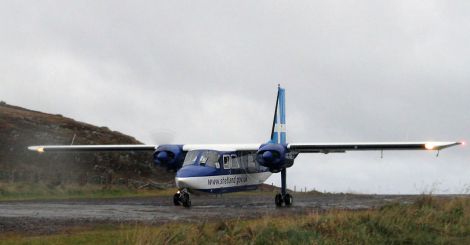Transport / Government raises idea of leasing zero carbon planes in Highlands and Islands
THE SCOTTISH Government has floated the idea of leasing zero or low carbon airplanes to flight operators in the Highlands and Islands in a bid to reduce emissions in the aviation sector.
It has also raised the suggestion of demand-led airplane ‘taxis’ in the region as well as flights chartered by regular users such as the NHS or oil and gas companies which the public could book onto.
The ideas feature in a discussion paper prepared for the government’s ongoing consultation on the aviation sector.
The consultation will inform the development of an aviation strategy, which will cover areas like emissions, international and domestic connectivity, and air freight.
With the climate at the forefront of thinking following the COP26 conference, reducing emissions in transport is a key factor.
The discussion paper said the short distances and low passenger volumes on many of the scheduled flights within Scotland “mean they are ideally suited to early adoption of zero and low emission aircraft”.
“However, as most scheduled passenger flights in Scotland are operated on a commercial basis, the airlines rather than the Scottish Government decide what aircraft they will use on their routes,” the report continues.
“One option to help ensure the early use of zero and low emission aircraft on routes in the Highland and Islands, is for the Scottish Government to purchase new zero emission aircraft as they become available on the market, then lease them to the airline(s) operating the routes.
“This means that the airline(s) does not need to make the initial capital expenditure, but can still benefit from the lower operating costs of using these kinds of aircraft.
“It also means that, through the leasing costs, the Scottish Government will be able to recoup the costs of the initial investment, whilst accelerating the transition to low and zero emission aircraft.
Become a member of Shetland News
“Lower operating costs compared to conventional aircraft may also lead to a reduction in airfares.”
It said this would be similar to the current arrangement of Highlands and Islands Airports Ltd (HIAL) owning two Twin Otter planes which are leased to Loganair for short routes.
Decarbonising transport is already on minds in Shetland in the drive to net zero, with the inter-island ferries identified as the council’s most significant carbon emitters.
When it comes to flights, the council pays Airtask to run short trips from Tingwall to Fair Isle and Foula.
Shetland Islands Council’s (SIC) environment and transport committee chairman Ryan Thomson said the leasing idea is “very exciting”.
“Over the coming years, the SIC alongside ZetTrans and the Scottish Government must look at all aspects of our transport network if we are to achieve our climate change targets and eventually lead to a net zero future plan for Shetland and Scotland,” he said.
“Shetland’s carbon footprint is twice that of the national average, taking into account or unique, rural setting.
“But we must look at achieving net zero while maintaining lifeline links for our remote islands.
“While addressing the environmental issues around flying, lower operating costs should lead also to a reduction in air fares which is a well known barrier for most of us.”
The prospect of electric buses and exploring funding avenues was also raised during a meeting of local transport partnership ZetTrans on Thursday.
But members were told that current funding schemes tend to be designed more for large mainland operators like Stagecoach.
Meanwhile two new possible operating models for flights in the Highlands and Islands were also raised in the government discussion paper.
One was an “air taxi” where services would be demand responsive, likely with smaller aircraft, rather than working to a set timetable.
Another was “open charter services” where organisations with larger travel requirements such as the NHS or the oil and gas industry provide base demand which operates at times best for them.
But the service would also be available to the public.
The discussion paper also asks how effective the Air Discount Scheme, which offers half price flights for islanders, has been.
HIAL, which has Sumburgh Airport in its network, is overseeing the UK’s first operationally-based, low-carbon aviation test centre in Kirkwall.
It will host trials involving planes using electric, hydrogen or synthetic fuel.
HIAL has an ambition to decarbonise operations by 2040, as does regional airline Loganair which runs flights from the islands to the Scottish mainland.
A large drone, which undertook trial flights from Orkney to Fair Isle, has also been involved with the test centre.
The drone company – which looks at using unmanned aerial vehicles for transporting items like medical supplies – is also planning to fly within Shetland next year.
Scotland’s first electric-powered aircraft also took off from the test centre in Orkney earlier this year for a trial trip to Wick.
Become a member of Shetland News
Shetland News is asking its many readers to consider paying for membership to get additional features and services: -
- Remove non-local ads;
- Bookmark posts to read later;
- Exclusive curated weekly newsletter;
- Hide membership messages;
- Comments open for discussion.
If you appreciate what we do and feel strongly about impartial local journalism, then please become a member of Shetland News by either making a single payment, or setting up a monthly, quarterly or yearly subscription.































































